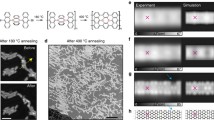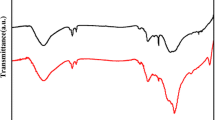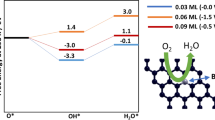Abstract
Ammonia N–H bond cleavage at metal-free substrates has attracted great attention because of its industrial importance. Here, we investigate the dissociative adsorption of ammonia onto the surface of a B36 borophene sheet by means of density functional theory calculations. We show that the N–H bond may be broken at the edges of B36 even at room temperature, regarding the small energy barrier of 14.1–19.3 kcal mol−1 at different levels of theory, and more negative Gibbs free energy change. Unlike basis set size, the kind of exchange correlation functional significantly affects the electronic properties of the studied systems. Also, by increasing the percentage of Hartree Fock (HF) exchange of density functionals, the activation and adsorption energies are lowered. A linear relationship between the highest occupied molecular orbital or lowest unoccupied molecular orbital of B36 borophene and the %HF exchange of functionals is predicted. Our work reveals that pure whole boron nanosheets may be promising metal-free materials in N–H bond cleavage, which would raise the potential application of these sheets.






Similar content being viewed by others
References
Nakajima Y, Kameo H, Suzuki H (2006) Cleavage of nitrogen–hydrogen bonds of ammonia induced by triruthenium polyhydrido clusters. Angew Chem Int Ed 45(6):950–952
Zhao J, Goldman AS, Hartwig JF (2005) Oxidative addition of ammonia to form a stable monomeric amido hydride complex. Science 307(5712):1080–1082
Zhao J-X, Xiao B, Ding Y-H (2009) Theoretical prediction of the N−H and O−H bonds cleavage catalyzed by the single-walled silicon carbide nanotube. J Phys Chem C 113(38):16736–16740
Moradi M, Peyghan AA, Bagheri Z, Kamfiroozi M (2012) Cation-π interaction of alkali metal ions with C24 fullerene: a DFT study. J Mol Model 18:3535–3540
Beheshtian J, Baei MT, Peyghan AA, Bagheri Z (2012) Electronic sensor for sulfide dioxide based on AlN nanotubes: a computational study. J Mol Model 18:4745–4750
Peyghan AA, Noei M, Tabar MB (2013) A large gap opening of graphene induced by the adsorption of Co on the Al-doped site. J Mol Model 19(8):3007–3014
Ahmadi A, Beheshtian J, Kamfiroozi M (2012) Benchmarking of ONIOM method for the study of NH3 dissociation at open ends of BNNTs. J Mol Model 18(5):1729–1734
Beheshtian J, Ahmadi Peyghan A, Bagheri Z (2013) Ab initio study of NH 3 and H 2 O adsorption on pristine and Na-doped MgO nanotubes. Struct Chem 24:165–170
Beheshtian J, Peyghan AA, Bagheri Z (2012) Carbon nanotube functionalization with carboxylic derivatives: a DFT study. J Mol Model 19:391–396
Soltani A, Ahmadi Peyghan A, Bagheri Z (2013) H2O2 adsorption on the BN and SiC nanotubes: a DFT study. Phys E 48:176–180
Ahmadi A, Beheshtian J, Hadipour NL (2011) Chemisorption of NH3 at the open ends of boron nitride nanotubes: a DFT study. Struct Chem 22(1):183–188
Pham HT, Duong LV, Tam NM, Pham-Ho MP, Nguyen MT (2014) The boron conundrum: bonding in the bowl B30 and B36, fullerene B40 and triple ring B42 clusters. Chem Phys Lett 608:295–302
Li W-L, Chen Q, Tian W-J, Bai H, Zhao Y-F, Hu H-S, Li J, Zhai H-J, Li S-D, Wang L-S (2014) The B35 Cluster with a double-hexagonal vacancy: a new and more flexible structural motif for borophene. J Am Chem Soc 136(35):12257–12260
Li W-L, Pal R, Piazza ZA, Zeng XC, Wang L-S (2015) B27−: Appearance of the smallest planar boron cluster containing a hexagonal vacancy. J Chem Phys 142(20):204305
Piazza ZA, Hu H-S, Li W-L, Zhao Y-F, Li J, Wang L-S (2014) Planar hexagonal B36 as a potential basis for extended single-atom layer boron sheets. Nat Commun 5:3113–3117
Chen Q, Wei G-F, Tian W-J, Bai H, Liu Z-P, Zhai H-J, Li S-D (2014) Quasi-planar aromatic B 36 and B 36− clusters: all-boron analogues of coronene. Phys Chem Chem Phys 16(34):18282–18287
Liu C-S, Wang X, Ye X-J, Yan X, Zeng Z (2014) Curvature and ionization-induced reversible hydrogen storage in metalized hexagonal B36. J Chem Phys 141(19):194306
Valadbeigi Y, Farrokhpour H, Tabrizchi M (2015) Adsorption of small gas molecules on B36 nanocluster. J Chem Sci 127(11):2029–2038
Grimme S (2006) Semiempirical GGA-type density functional constructed with a long-range dispersion correction. J Comput Chem 27:1787–1799
Schmidt MW, Baldridge KK, Boatz JA, Elbert ST, Gordon MS, Jensen JH, Koseki S, Matsunaga N, Nguyen KA, Su S (1993) General atomic and molecular electronic structure system. J Comput Chem 14(11):1347–1363
Politzer P, Murray JS (2002) The fundamental nature and role of the electrostatic potential in atoms and molecules. Theor Chem Accounts 108(3):134–142
Politzer P, Murray JS (1991) Molecular electrostatic potentials and chemical reactivity. Rev Comput Chem 2:273–312
Wiberg KB (1997) Properties of some condensed aromatic systems. J Org Chem 62(17):5720–5727
Beheshtian J, Peyghan AA, Bagheri Z (2012) Detection of phosgene by Sc-doped BN nanotubes: a DFT study. Sensors Actuators B: Chem 171–172:846–852
Ahmadi A, Hadipour NL, Kamfiroozi M, Bagheri Z (2012) Theoretical study of aluminum nitride nanotubes for chemical sensing of formaldehyde. Sensors Actuators B: Chem 161:1025–1029
Peyghan AA, Hadipour NL, Bagheri Z (2013) Effects of Al doping and double-antisite defect on the adsorption of HCN on a BC2N nanotube: density functional theory studiess. J Phys Chem C 117(5):2427–2432
Baei MT, Peyghan AA, Bagheri Z (2012) A computational study of AlN nanotube as an oxygen detector. Chin Chem Lett 23:965–968
Baei MT, Peyghan AA, Bagheri Z, Tabar MB (2012) B-doping makes the carbon nanocones sensitive towards NO molecules. Phys Lett A 377:107–111
Beheshtian J, Peyghan AA, Bagheri Z, Kamfiroozi M (2012) Interaction of small molecules (NO, H2, N2, and CH4) with BN nanocluster surface. Struct Chem 23:1567–1572
Beheshtian J, Peyghan AA, Noei M (2013) Sensing behavior of Al and Si doped BC3 graphenes to formaldehyde. Sensors Actuators B: Chem 181:829–834
Zhao Y, Truhlar DG (2006) A new local density functional for main-group thermochemistry, transition metal bonding, thermochemical kinetics, and noncovalent interactions. J Chem Phys 125(19):194101
Zhao Y, Truhlar DG (2008) The M06 suite of density functionals for main group thermochemistry, thermochemical kinetics, noncovalent interactions, excited states, and transition elements: two new functionals and systematic testing of four M06-class functionals and 12 other functionals. Theor Chem Accounts 120(1-3):215–241
Zhao Y, Truhlar DG (2006) Density functional for spectroscopy: no long-range self-interaction error, good performance for Rydberg and charge-transfer states, and better performance on average than B3LYP for ground states. J Phys Chem A 110(49):13126–13130
Peyghan AA, Noei M (2014) The alkali and alkaline earth metal doped ZnO nanotubes: DFT studies. Phys B Condens Matter 432:105–110
Beheshtian J, Peyghan AA, Bagheri Z, Tabar MB (2013) Density-functional calculations of HCN adsorption on the pristine and Si-doped graphynes. Struct Chem 25:1–7
Peyghan AA, Noei M (2014) Hydrogen fluoride on the pristine, Al and Si doped BC2N nanotubes: a computational study. Comput Mater Sci 82:197–201
Beheshtian J, Peyghan AA, Bagheri Z (2013) Sensing behavior of Al-rich AlN nanotube toward hydrogen cyanide. J Mol Model 19(6):2197–2203
Cohen AJ, Mori-Sánchez P, Yang W (2008) Insights into current limitations of density functional theory. Science 321(5890):792–794
Peng C, Schlegel HB (1993) Combining synchronous transit and quasi-Newton methods to find transition states. Isr J Chem 33(4):449–454
Author information
Authors and Affiliations
Corresponding author
Electronic supplementary material
Below is the link to the electronic supplementary material.
ESM 1
(GIF 927 kb)
Rights and permissions
About this article
Cite this article
Rostami, Z., Soleymanabadi, H. N–H bond cleavage of ammonia on graphene-like B36 borophene: DFT studies. J Mol Model 22, 70 (2016). https://doi.org/10.1007/s00894-016-2954-8
Received:
Accepted:
Published:
DOI: https://doi.org/10.1007/s00894-016-2954-8




